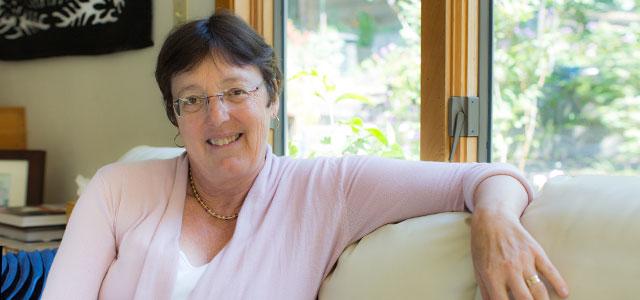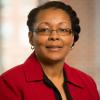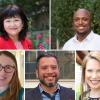
Tekoa King (photo by Elisabeth Fall)
Volunteer Faculty: Tekoa King Brings Evidence-Based Collaborative Practice to Midwifery and Medical Students
In 1975, when Tekoa King – who today is a clinical professor at UC San Francisco School of Nursing and in UC San Francisco School of Medicine’s Department of Obstetrics, Gynecology and Reproductive Sciences – got her BSN from the School, it seemed she might spend her career tending to the seriously ill and dying. As a volunteer for Shanti Project (which provides emotional and practical support for those with life-threatening illness) and, soon after graduation, a nurse on Children’s Hospital Oakland’s pediatric oncology ward, she was intellectually curious about illness and death and enjoyed helping people approaching the end of life. However, when a School faculty member handed her a brochure on Frontier Nursing University’s midwifery program, it changed her direction and her life.
“I was amazed,” she says. “I wanted to take my career a little further, and I realized that I could do more independently as a midwife than I could as a nurse practitioner caring for children with cancer.”
At the time, midwifery was largely relegated to rural and underserved parts of the country, and there were no midwifery programs in California. King crossed the country to enroll in Georgetown University’s nurse-midwifery program in 1977. After receiving her CNM (certified nurse-midwife) credential, she spent a year working at a maternity home for unwed mothers in Philadelphia, then returned to the Bay Area, where her husband was completing a PhD at UC Berkeley. With several other midwives, King started a midwifery practice at Mount Zion Hospital, one of the first in the state. When Mount Zion began its move to merge with UCSF in 1989, she decided to take some time off to pursue a master’s in public health at UC Berkeley.
Students Everywhere
After completing her MPH in 1990, King was invited to join the CNM-OB collaborative practice at UCSF, where she got her first taste of teaching.
“In that practice, the academic part of your life became obvious,” she says. “I had students with me everywhere.” She began teaching both midwifery students (UCSF had started a nurse-midwifery certificate program in 1977) and medical students and interns how to do deliveries, and eventually was asked to give lectures in what today is the Department of Obstetrics, Gynecology and Reproductive Sciences. “I learned the pleasure of academic work as opposed to just clinical,” she says.
Bringing Evidence-Based Practice to Light
One of King’s lectures, on premature rupture of membranes, was accepted as an article in the Journal of Midwifery & Women’s Health, the peer-reviewed journal of the American College of Nurse-Midwives (ACNM), and a new facet of her career was born. After writing several more articles, she was invited to become a reviewer for the journal, and in 2001, she was offered the position of editor-in-chief and made the decision to stop doing births to focus on improving the journal and bringing it to electronic venues.
When she stepped back six years later to take the position of deputy editor, she took up teaching again, conducting outreach lectures for nurses in small hospitals around Northern California. The program allows smaller hospitals to send their sickest babies to UCSF and receive education from UC specialists like King.
Research has remained an important part of King’s career since that first paper was accepted, and she’s worked on projects with UCSF faculty and other researchers. In 1996, she was invited to help the Centers for Disease Control and Prevention (CDC) create national guidelines on preventing perinatal group B strep infections, and having developed a reputation as an expert on fetal heart rate (FHR) monitoring, she’s also served on National Institutes of Health (NIH) committees on FHR and vaginal birth after cesarean (VBAC).
“They [NIH] set up their panels in a unique way,” she says. “They pick experts from all over – physicians, nursing, anesthesia, midwifery – and then you go through lots of articles and listen to three days of talks and then come up with a consensus statement.”
Teaching the Evidence
King continues to work in the outreach program and teaches midwifery and medical students as a clinical professor for the School of Nursing and as co-director of the Department of Obstetrics, Gynecology and Reproductive Sciences’ antenatal conference, held each June. She enjoys the way students make her think and examine her knowledge and biases.
“It keeps you honest as a clinician and a professional,” she says. For King, that means abandoning a particular philosophy of care where it doesn’t best serve the patient or student. “You have to do the right thing for them, regardless of medical or midwifery philosophy. You want your professional culture and identity to support you but not limit you.”
Expanding Collaborative Practice
This fits with a midwifery career that has always been based on interdisciplinary collaborative practice; she’s seen the way it improves care and is pleased that it’s becoming more prevalent. Kaiser Permanente in Oakland recently asked her to help them set up a collaborative midwifery practice.
“They really want midwives and physicians who aren’t hidebound by culture,” she says. “Patients get infinitely better care if you’re a team, but there are rules to what makes it work. You have to be flexible mentally.”
The biggest challenge King says she’s faced in her career has been finding the time to do everything as well as she wanted, balancing family and career commitments. She’s somewhat surprised at how well she’s managed. In 2013, the ACNM recognized her with its highest honor, the Hattie Hemschemeyer Award, for her contributions to maternal/fetal health. “I was so amazed!” she says. “I didn’t expect it.”
King says she’d encourage midwives in practice to consider teaching. “It exposes students to people who are out there in different aspects of the profession, and it helps the faculty because it exposes them to the students’ curiosity,” she says. “It’s what I’ve liked most of everything I’ve ever done.”



